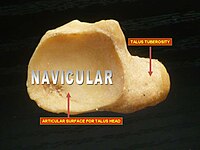Navicular bone
| Navicular bone | |
|---|---|
 Bones of the human foot, with Navicularis labeled at upper left in image. | |
| Details | |
| Identifiers | |
| Latin | os naviculare |
| TA98 | A02.5.12.001 |
| TA2 | 1484 |
| FMA | 24499 |
| Anatomical terms of bone | |
The navicular bone /nəˈvɪkjʊlər/ is a small bone found in the feet of most mammals.
Human anatomy
The navicular bone in humans is one of the tarsal bones, found in the foot. Its name derives from the human bone's resemblance to a small boat, caused by the strongly concave proximal articular surface. The term navicular bone or hand navicular bone was formerly used for the scaphoid bone,[1] one of the carpal bones of the wrist.
The navicular bone in humans is located on the
.It is the last of the foot bones to start ossification and does not tend to do so until the end of the third year in girls and the beginning of the fourth year in boys, although a large range of variation has been reported.[2]

The tibialis posterior is the only muscle that attaches to the navicular bone. The main portion of the muscle inserts into the tuberosity of the navicular bone.[3] An accessory navicular bone may be present in 2–14% of the general population.[4][5][6]
Clinical significance
The human navicular is not a commonly broken bone but it breaks due to two reasons. The first mechanism is a stress fracture which happens commonly in athletes [7] and the other mechanism is a high energy trauma.
The navicular bone is a keystone of the foot: it is part of the coxa pedis and articulates with the talus, first, second and third cuneiform, cuboid and calcaneus. It plays an important role in the biomechanics of the foot, helping in inversion, eversion, and motion; it is a structural link between midfoot and forefoot and it is part of the longitudinal and transverse arch of the foot.
Horse anatomy
The horse has a
The navicular region is an important structure in relation to lameness, particularly in the front feet, and is involved with a significant disease process called navicular disease or navicular syndrome. Recently much of the original literature concerning navicular disease has been called into question, particularly the significance of
See also
- Bone terminology
- Terms for anatomical location
- Equine forelimb anatomy
Notes
- ^ "Gray's Anatomy, 6b. The Hand. 1. The Carpus. 4". 1918. Retrieved 11 May 2018.
- ISBN 9780080474595.
- ISBN 978-87-628-0307-7.
- ^ "Top Rated Foot Surgeons - Foot & Ankle Institute in Baltimore- Mercy". Mercy Medical Center.
- ^ "Accessory Navicular". 2 June 2020.
- ^ www.mynameiskaan.com. "Macrorad Teleradiology Case Report - SYMPTOMATIC ACCESSORY NAVICULAR BONE".
- ^ "Medical Update On Pau Gasol". Milwaukee Bucks. Retrieved 8 December 2019.
- ^ a b R. Wayne Waguespack, DVM, MS, DACVS R. Reid Hanson, DVM, DACVS, DACVECC (December 2010). "Navicular Syndrome in Equine Patients: Anatomy, Causes, and Diagnosis" (PDF). Surgical Views. Auburn University. Archived from the original (PDF) on 21 October 2012. Retrieved 11 January 2013.
{{cite web}}: CS1 maint: multiple names: authors list (link) - ^ "Chapter 32, FRACTURE AND LUXATION OF THE TARSUS AND METATARSUS "Textbook of Small Animal Orthopaedics" written by Charles D. Newton, D.V.M., M.S. and David M. Nunamaker, V.M.D. J.B. Lippincott Company, 1985". Archived from the original on 19 January 2013. Retrieved 11 January 2013.
- ^ Citing Clinical Anatomy and Physiology Laboratory Manual for Veterinary Technicians, Colville, Thomas and Bassert, Joanna M. 2008 Publ. Mosby/Elsevier, Canada. "Navicular Bone - The distal sesamoid bone of the horse. The navicular bone is located deep in the hoof behind the joint between the middle and distal phalanges."
External links
- 3D printable navicular bone model, free download in STL format (Embodi3D.com)


